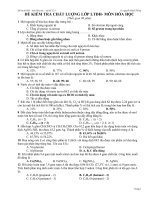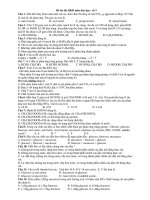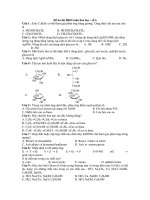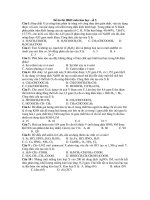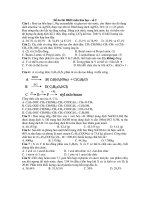Đề ôn thi thử môn hóa (579)
Bạn đang xem bản rút gọn của tài liệu. Xem và tải ngay bản đầy đủ của tài liệu tại đây (126.72 KB, 5 trang )
e1
References
1. Hsu DT, Pearson GD. Heart failure in children: part II: diagnosis,
treatment, and future directions. Circ Heart Fail. 2009;2:490-498.
2. Nandi D, Rossano JW. Epidemiology and cost of heart failure in
children. Cardiol Young. 2015;25:1460-1468.
3. Hinton RB, Ware SM. Heart failure in pediatric patients with congenital heart disease. Circ Res. 2017;120:978-994.
4. Gournay V, Hauet Q. Mechanical circulatory support for infants
and small children. Arch Cardiovasc Dis. 2014;107:398-405.
5. Karagiannidis C, Brodie D, Strassmann S, et al. Extracorporeal
membrane oxygenation: evolving epidemiology and mortality. Intensive Care Med. 2016;42:889-896.
6. Ouweneel DM, Schotborgh JV, Limpens J, et al. Extracorporeal life
support during cardiac arrest and cardiogenic shock: a systematic
review and meta-analysis. Intensive Care Med. 2016;42:1922-1934.
7. Chandler HK, Kirsch R. Management of the low cardiac output
syndrome following surgery for congenital heart disease. Curr Cardiol Rev. 2016;12:107-111.
8. Lomivorotov VV, Efremov SM, Kirov MY, Fominskiy EV, Karaskov
AM. Low-cardiac-output syndrome after cardiac surgery. J Cardiothorac Vasc Anesth. 2017;31:291-308.
9. Chen S, Dykes JC, McElhinney DB, et al. Haemodynamic profiles of
children with end-stage heart failure. Eur Heart J. 2017;38:2900-2909.
10. Bautista-Hernandez V, Almodovar MC. Thematic issue: pharmacologic
strategies with afterload reduction in low cardiac output syndrome after
pediatric cardiac surgery. Curr Vasc Pharmacol. 2016;14:3-4.
11. Chandler HK, Kirsch R. Management of the low cardiac output
syndrome following surgery for congenital heart disease. Curr Cardiol Rev. 2016;12:107-111.
12. Pérez-Navero, JL, de la Torre-Aguilar MJ, Ibarra de la Rosa I, et al.
Cardiac biomarkers of low cardiac output syndrome in the postoperative period after congenital heart disease surgery in children. Rev
Esp Cardiol (Engl Ed). 2017;70:267-274.
13. Epting CL, McBride ME, Wald EL, Costello JM. Pathophysiology of
post-operative low cardiac output syndrome. Curr Vasc Pharmacol.
2016;14(1):14-23. Available at: />article.
14. Yuerek M, Rossano JW, Mascio CE, Shaddy RE. Postoperative management of heart failure in pediatric patients. Expert Rev Cardiovasc
Ther. 2016;14:201-215.
15. Boehne M, Sasse M, Karch A, et al. Systemic inflammatory response
syndrome after pediatric congenital heart surgery: incidence, risk
factors, and clinical outcome. J Card Surg. 2017;32:116-125.
16. Wernovsky G, Wypij D, Jonas RA, et al. Postoperative course and
hemodynamic profile after the arterial switch operation in neonates
and infants. A comparison of low-flow cardiopulmonary bypass and
circulatory arrest. Circulation. 1995;92:2226-2235.
17. Burkhardt BEU, Rucker G, Stiller B. Prophylactic milrinone for
the prevention of low cardiac output syndrome and mortality in
children undergoing surgery for congenital heart disease. Cochrane
Database Syst Rev. 2015;(3):CD009515.
18. Hummel J, Rucker G, Stiller B. Prophylactic levosimendan for the
prevention of low cardiac output syndrome and mortality in paediatric
patients undergoing surgery for congenital heart disease. Cochrane
Database Syst Rev. 2017;3:CD011312.
19. Gasparovic H, Gabelica R, Ostojic Z, et al. Diagnostic accuracy of
central venous saturation in estimating mixed venous saturation is
proportional to cardiac performance among cardiac surgical patients.
J Crit Care. 2014;29:828-834.
20. Mayer K, Trzeciak S, Puri NK. Assessment of the adequacy of oxygen delivery. Curr Opin Crit Care. 2016;22:437-443.
21. Basaran M, Sever K, Kafali E, et al. Serum lactate level has prognostic significance after pediatric cardiac surgery. J Cardiothorac Vasc
Anesth. 2006;20:43-47.
22. Schumacher KR, Reichel RA, Vlasic JR, et al. Rate of increase in
serum lactate level risk-stratifies infants after surgery for congenital
heart disease. J Thorac Cardiovasc Surg. 2014;148:589-595.
23. Ranucci M, Pistuddi V, Pisani GP, et al. Retuning mortality risk
prediction in paediatric cardiac surgery: the additional role of early
postoperative metabolic and respiratory profile. Eur J Cardiothorac
Surg. 2016;50:642-649.
24. Aly SA, Zurakowski D, Glass P, Skurow-Todd K, Jonas RA, Donofrio MT. Cerebral tissue oxygenation index and lactate at 24 hours
postoperative predict survival and neurodevelopmental outcome after neonatal cardiac surgery. Congenit Heart Dis. 2017;12:188-195.
25. Friedland-Little JM, Hirsch-Romano JC, Yu S, et al. Risk factors for
requiring extracorporeal membrane oxygenation support after a
Norwood operation. J Thorac Cardiovasc Surg. 2014;148:266-272.
26. Osman D, Ridel C, Ray P, et al. Cardiac filling pressures are not
appropriate to predict hemodynamic response to volume challenge.
Crit Care Med. 2007;35:64-68.
27. Molina Hazan V, Gonen Y, Vardi A, et al. Blood lactate levels differ
significantly between surviving and nonsurviving patients within the
same risk-adjusted Classification for Congenital Heart Surgery
(RACHS-1) group after pediatric cardiac surgery. Pediatr Cardiol.
2010;31:952-960.
28. Vogt W, Läer S. Prevention for pediatric low cardiac output syndrome: results from the European survey EuLoCOS-Paed. Paediatr
Anaesth. 2011;21:1176-1184.
29. Kumar A, Anel R, Bunnell E, et al. Pulmonary artery occlusion pressure and central venous pressure fail to predict ventricular filling
volume, cardiac performance, or the response to volume infusion in
normal subjects. Crit Care Med. 2004;32:691-699.
30. Berlin DA, Bakker J. Starling curves and central venous pressure.
Crit Care. 2015;19:55.
31. Marik PE, Cavallazzi R, Vasu T, Hirani A. Dynamic changes in arterial waveform derived variables and fluid responsiveness in mechanically ventilated patients: a systematic review of the literature. Crit
Care Med. 2009;37:2642-2647.
32. Mahmood SS, Pinsky MR. Heart-lung interactions during
mechanical ventilation: the basics. Ann Transl Med. 2018;6:349.
33. Redlin M, Koster A, Huebler M, et al. Regional differences in
tissue oxygenation during cardiopulmonary bypass for correction of
congenital heart disease in neonates and small infants: relevance of
near-infrared spectroscopy. J Thorac Cardiovasc Surg. 2008;136:
962-967.
34. Murkin JM, Arango M. Near-infrared spectroscopy as an index of
brain and tissue oxygenation. Br J Anaesth. 2009;103(suppl 1):
i3-i13.
35. Proulx F, Lemson J, Choker G, Tibby SM. Hemodynamic monitoring by transpulmonary thermodilution and pulse contour analysis in
critically ill children. Pediatr Crit Care Med. 2011;12:459-466.
36. Maldonado Y, Singh S, Taylor MA. Cerebral near-infrared spectroscopy in perioperative management of left ventricular assist device
and extracorporeal membrane oxygenation patients. Curr Opin Anaesthesiol. 2014;27:81-88.
37. Tume LN, Arnold P. Near-infrared spectroscopy after high-risk congenital heart surgery in the paediatric intensive care unit. Cardiol
Young. 2015;25:459-467.
38. Hoffman GM, Ghanayem NS, Scott JP, et al. Postoperative cerebral
and somatic near-infrared spectroscopy saturations and outcome in
hypoplastic left heart syndrome. Ann Thorac Surg. 2017;103:15271535.
39. Nagdyman N, Ewert P, Peters B, Miera O, Fleck T, Berger F. Comparison of different near-infrared spectroscopic cerebral oxygenation
indices with central venous and jugular venous oxygenation saturation in children. Paediatr Anaesth. 2008;18:160-166.
40. Lewis C, Parulkar SD, Bebawy J, Sherwani S, Hogue CW. Cerebral
neuromonitoring during cardiac surgery: a critical appraisal with an
emphasis on near-infrared spectroscopy. J Cardiothorac Vasc Anesth.
2018;32:2313-2322.
41. Guan Z, Liu J-J, Yuan H, Gao Y-F. Positive correlation between regional cerebral oxygen saturation and mixed venous oxygen saturation during off-pump coronary artery bypass surgery. Respir Care.
2018;63:988-993.
e2
42. Fakler U, Pauli Ch, Balling G, et al. Cardiac index monitoring by
pulse contour analysis and thermodilution after pediatric cardiac
surgery. J Thorac Cardiovasc Surg. 2007;133:224-228.
43. Kutter APN, Bektas RN, Hofer CK, Larenza Menzies MP, Bettschart-Wolfensberger R. Trending ability and limitations of transpulmonary thermodilution and pulse contour cardiac output measurement in cats as a model for pediatric patients. J Clin Monit Comput.
2015;29:377-383.
44. Udy AA, Altukroni M, Jarrett P, Roberts JA, Lipman J. A comparison
of pulse contour wave analysis and ultrasonic cardiac output monitoring in the critically ill. Anaesth Intensive Care. 2012;40:631-637.
45. Zorko DJ, hoong K, Gilleland J, et al. Urgent ultrasound guided
hemodynamic assessments by a pediatric medical emergency team: a
pilot study. PLoS One. 2013;8:e66951-e66951.
46. Beltramo F, Menteer J, Razavi A, et al. Validation of an ultrasound
cardiac output monitor as a bedside tool for pediatric patients. Pediatr
Cardiol. 2016;37:177-183.
47. Razavi A, Newth CJL, Khemani RG, Beltramo F, Ross PA. Cardiac
output and systemic vascular resistance: Clinical assessment compared with a noninvasive objective measurement in children with
shock. J Crit Care. 2017;39:6-10.
48. Gaies M, Cooper DS, Tabbutt S, et al. Collaborative quality improvement in the cardiac intensive care unit: development of the
Paediatric Cardiac Critical Care Consortium (PC4). Cardiol Young.
2015;25:951-957.
49. Meert KL, Notterman DA. The Collaborative Pediatric Critical Care
Research Network: Recent Progress and Future Directions. Pediatr
Clin North Am. 2017;64:xvii-xix.
50. Leow EH, Chan YH, Ng YH, Lim JKB, Nakao M, Lee JH. Prevention
of acute kidney injury in children undergoing cardiac surgery: a narrative review. World J Pediatr Congenit Heart Surg. 2018;9:79-90.
51. Kouatli AA, Garcia JA, Zellers TM, Weinstein EM, Mahony L.
Enalapril does not enhance exercise capacity in patients after Fontan
procedure. Circulation. 1997;96:1507-1512.
52. Hsu DT, Zak V, Mahony L, et al. Enalapril in infants with single
ventricle: results of a multicenter randomized trial. Circulation.
2010;122:333-340.
53. Roche SL, Timberlake K, Manlhiot C, et al. Angiotensin-converting
enzyme inhibitor initiation and dose uptitration in children with
cardiovascular disease: a retrospective review of standard clinical
practice and a prospective randomized clinical trial. J Am Heart Assoc.
2016;5:e003230.
54. Yimgang DP, Sorkin JD, Evans CF, Abraham DS, Rosenthal GL.
Angiotensin converting enzyme inhibitors and interstage failure in
infants with hypoplastic left heart syndrome. Congenit Heart Dis.
2018;13:533-540.
55. Alabed S, Sabouni A, Al Dakhoul S, Bdaiwi Y, Frobel-Mercier A-K.
Beta-blockers for congestive heart failure in children. Cochrane Database Syst Rev. 2016;(1):CD007037.
56. Rossano JW, Cabrera AG, Jefferies JL, Naim, MPHMY, Humlicek, T.
Pediatric Cardiac Intensive Care Society 2014 consensus statement:
pharmacotherapies in cardiac critical care chronic heart failure. Pediatr
Crit Care Med. 2016;17:S20-S34.
57. Huang M, Zhang X, Chen S, et al. The effect of carvedilol treatment
on chronic heart failure in pediatric patients with dilated cardiomyopathy: a prospective, randomized-controlled study. Pediatr Cardiol.
2013;34:680-685.
58. Shaddy RE, Boucek MM, Hsu DT, et al. Carvedilol for children and
adolescents with heart failure: a randomized controlled trial. JAMA.
2007;298:1171-1179.
59. Lasa JJ, Gaies M, Bush L, et al. Epidemiology and outcomes of acute
decompensated heart failure in children. Circ Heart Fail. 2020;13:e006101.
60. Barton P, Garcia J, Kouatli A, et al. Hemodynamic effects of i.v.
milrinone lactate in pediatric patients with septic shock. A prospective, double-blinded, randomized, placebo-controlled, interventional study. Chest. 1996;109:1302-1312.
61. Hoffman TM, Wernovsky G, Atz AM, et al. Efficacy and safety of
milrinone in preventing low cardiac output syndrome in infants and
children after corrective surgery for congenital heart disease. Circulation. 2003;107:996-1002.
62. Nakano SJ, Miyamoto SD, Movsesian M, Nelson P, Stauffer BL,
Sucharov CC. Age-related differences in phosphodiesterase activity
and effects of chronic phosphodiesterase inhibition in idiopathic
dilated cardiomyopathy. Circ Heart Fail. 2015;8:57-63.
63. Gist KM, Goldstein SL, Joy MS, Vinks AA. Milrinone dosing issues
in critically ill children with kidney injury: a review. J Cardiovasc
Pharmacol. 2016;67:175-181.
64. Shimizu M, Nishinaka T, Inai K, Nakanishi T. Outcomes in children
with advanced heart failure in Japan: importance of mechanical circulatory support. Heart Vessels. 2016;31:1162-1167.
65. Park I-S. Efficacy of pulmonary vasodilator therapy in patients with
functionally single ventricle. Int Heart J. 2015;56(suppl):S26-S30.
66. Hill KD, Sampson MR, Li JS, Tunks RD, Schulman SR, CohenWolkowiez M. (2016). Pharmacokinetics of intravenous sildenafil in
children with palliated single ventricle heart defects: effect of elevated hepatic pressures. Cardiol Young. 2016;26:354-362.
67. Hornik CP, Onufrak NJ, Smith PB, et al. Association between oral
sildenafil dosing, predicted exposure, and systemic hypotension in
hospitalised infants. Cardiol Young. 2018;28:85-92.
68. Lechner E, Hofer A, Leitner-Peneder G, et al. Levosimendan versus
milrinone in neonates and infants after corrective open-heart surgery: a pilot study. Pediatr Crit Care Med. 2012;13:542-548.
69. Ricci Z, Garisto C, Favia I, Vitale V, Di Chiara L, Cogo PE. Levosimendan infusion in newborns after corrective surgery for congenital
heart disease: randomized controlled trial. Intensive Care Med.
2012;38:1198-1204.
70. Joshi RK, Aggarwal N, Aggarwal M, Pandey R, Dinand V, Joshi R.
Successful use of levosimendan as a primary inotrope in pediatric
cardiac surgery: An observational study in 110 patients. Ann Pediatr
Cardiol. 2016;9:9-15.
71. Hummel J, Rucker G, Stiller B. Prophylactic levosimendan for
the prevention of low cardiac output syndrome and mortality in
paediatric patients undergoing surgery for congenital heart disease.
Cochrane Database Syst Rev. 2017;8:CD011312.
72. Zangrillo A, Biondi-Zoccai GG, Frati E, et al. Fenoldopam and
acute renal failure in cardiac surgery: a meta-analysis of randomized
placebo-controlled trials. J Cardiothorac Vasc Anesth. 2012;26:
407-413.
73. Gillies MA, Kakar V, Parker RJ, Honore PM, Ostermann M.
Fenoldopam to prevent acute kidney injury after major surgery-a systematic review and meta-analysis. Crit Care Lond Engl. 2015;19:449.
74. Ricci Z, uciano R, Favia I, et al. High-dose fenoldopam reduces
postoperative neutrophil gelatinase-associated lipocaline and cystatin
C levels in pediatric cardiac surgery. Crit Care. 2011;15:R160.
75. Lacroix J, Hebert PC, Hutchison, et al. Transfusion strategies for
patients in pediatric intensive care units. N Engl J Med. 2007;356:
1609-1619.
76. Cholette JM, Willems A, Valentine SL, Bateman ST, Schwartz SM.
Recommendations on RBC transfusion in infants and children with
acquired and congenital heart disease from the pediatric critical care
transfusion and anemia expertise initiative. Pediatr Crit Care Med.
2018;19:S137-S148.
77. Machovec KA, Jooste EH. Pediatric transfusion algorithms: coming
to a cardiac operating room near you. J Cardiothorac Vasc Anesth.
2019;33:2017-2029.
78. Zhang JQ, Yang QY, Xue FS, et al. Preoperative oral thyroid hormones to prevent euthyroid sick syndrome and attenuate myocardial
ischemia-reperfusion injury after cardiac surgery with cardiopulmonary bypass in children: A randomized, double-blind, placebo-controlled trial. Medicine (Baltimore). 2018;97:e12100.
79. Mackie AS, Booth KL, Newburger JW, et al. A randomized, doubleblind, placebo-controlled pilot trial of triiodothyronine in neonatal
heart surgery. J Thorac Cardiovasc Surg. 2005;130:810-816.
80. Marwali EM, Boom CE, Budiwardhana N, et al. Oral triiodothyronine for infants and children undergoing cardiopulmonary bypass.
Ann Thorac Surg. 2017;104:688-695.
e3
81. Flores S, Loomba RS, Checchia PA, Graham EM, Bronicki RA.
Thyroid hormone (triiodothyronine) therapy in children after congenital heart surgery: a meta-analysis. Semin Thorac Cardiovasc
Surg. 2020;32:87-95.
82. Clarizia NA, Manlhiot C, Schwartz SM, et al. Improved outcomes
associated with intraoperative steroid use in high-risk pediatric
cardiac surgery. Ann Thorac Surg. 2011;91:1222-1227.
83. Pasquali SK, Li JS, He X, et al. Perioperative methylprednisolone
and outcome in neonates undergoing heart surgery. Pediatrics.
2012;129:e385-e391.
84. Graham EM, Martin RH, Buckley JR, et al. Corticosteroid Therapy in neonates undergoing cardiopulmonary bypass: randomized
controlled trial. J Am Coll Cardiol. 2019;74:659-668.
85. Hill KD, Baldwin HS, Bichel DP, et al. Rationale and design of the
STeroids to REduce Systemic inflammation after infant heart Surgery (STRESS) trial. Am Heart J. 2020;220:192-202.
86. Agus MSD, Wypij D, Nadkarni. Tight glycemic control in critically Ill children. N Engl J Med. 2017;376:e48.
87. Vlasselaers D, Milants I, Desmet L, et al. Intensive insulin therapy
for patients in paediatric intensive care: a prospective, randomised
controlled study. Lancet. 2009;373:547-556.
88. Mesotten D, Preiser J-C, Kosiborod M. Glucose management in
critically ill adults and children. Lancet Diabetes Endocrinol. 2015;
3:723-733.
89. Soto-Rivera CL, Agus MSD, Sawyer JE, Macrae DJ. Pediatric
Cardiac Intensive Care Society 2014 consensus statement: pharmacotherapies in cardiac critical care hormone replacement therapy.
Pediatr Crit Care Med. 2016;17:S59-S68.
90. Matok I, Rubinshtein M, Levy A, et al. Terlipressin for children
with extremely low cardiac output after open heart surgery. Ann
Pharmacother. 2009;43:423-429.
91. Masarwa R, Paret G, Perlman A, Reif S, Raccah BH, Matok I. Role
of vasopressin and terlipressin in refractory shock compared to
conventional therapy in the neonatal and pediatric population: a
systematic review, meta-analysis, and trial sequential analysis. Crit
Care. 2017;21:1.
92. Siehr SL, Ivy DD, Miller-Reed K, Ogawa M, Rosenthal DN, Feinstein JA. Children with pulmonary arterial hypertension and prostanoid therapy: long-term hemodynamics. J Heart Lung Transplant.
2013;32:546-552.
93. Levy M, Del Cerro MJ, Nadaud S, et al. Safety, efficacy and Management of subcutaneous treprostinil infusions in the treatment of severe
pediatric pulmonary hypertension. Int J Cardiol. 2018;264:153-157.
94. Berger-Caron F, Piedboeuf B, Morissette G, et al. Inhaled Epoprostenol for Pulmonary Hypertension Treatment in Neonates: A 12Year Experience. Am J Perinatol. 2019;36:1142-1149.
95. Torbic H, Szumita PM, Anger KE, Nuccio P, LaGambina S, Weinhouse G. Inhaled epoprostenol vs inhaled nitric oxide for refractory
hypoxemia in critically ill patients. J Crit Care. 2013;28:844-848.
96. Torbic H. Management of pulmonary arterial hypertension in the
ICU. J Pharm Pract. 2019;32:303-313.
97. Rao V, Ghadimi K, Keeyapaj W, Parsons CA, Cheung AT. Inhaled
Nitric Oxide (iNO) and Inhaled Epoprostenol (iPGI2) Use in
Cardiothoracic Surgical Patients: Is there Sufficient Evidence for
Evidence-Based Recommendations? J Cardiothorac Vasc Anesth.
2018;32:1452-1457.
98. Askenazi DJ, Selewski DT, Paden ML, et al. Renal replacement
therapy in critically ill patients receiving extracorporeal membrane
oxygenation. Clin J Am Soc Nephrol. 2012;7:1328-1336.
99. Antonucci E, Lamanna I, Fagnoul D, Vincent JL, De Backer D,
Silvio Taccone F. The impact of renal failure and renal replacement
therapy on outcome during extracorporeal membrane oxygenation
therapy. Artif Organs. 2016;40:746-754.
100. Kumar TK, Zurakowski D, Dalton H, et al. Extracorporeal membrane oxygenation in postcardiotomy patients: factors influencing
outcome. J Thorac Cardiovasc Surg. 2010;140:330-336.e2.
101. Ford MA, Gauvreau K, McMullan DM, et al. Factors associated
with mortality in neonates requiring extracorporeal membrane
oxygenation for cardiac indications: analysis of the extracorporeal
life support organization registry data. Pediatr Crit Care Med. 2016;
17:860-870.
102. Lin JC. Extracorporeal membrane oxygenation for severe pediatric
respiratory failure. Respir Care. 2017;62:732-750.
103. Ammirati E, Cipriani M, Lilliu M, et al. Survival and left ventricular function changes in fulminant versus nonfulminant acute myocarditis. Circulation. 2017;136:529-545.
104. Jung SY, Shin HJ, Jung JW, et al. Extracorporeal life support can
be a first-line treatment in children with acute fulminant myocarditis. Interact Cardiovasc Thorac Surg. 2016;23:247-252.
105. Okada N, Murayama H, Hasegawa H, Kawai S, Mori H, Yasuda
K. Peripheral veno-arterial extracorporeal membrane oxygenation
as a bridge to decision for pediatric fulminant myocarditis. Artif
Organs. 2016;40:793-798.
106. Wu H-P, Lin M-J, Yang W-C, Wu K.-H, Chen C-Y. Predictors of
extracorporeal membrane oxygenation support for children with
acute myocarditis. Biomed Res Int. 2017;2017;2510695.
107. Saito S, Toda K, Miyagawa S, et al. Diagnosis, medical treatment,
and stepwise mechanical circulatory support for fulminant myocarditis. J Artif Organs. 2018;21:172-179.
108. Ambardekar AV, Buttrick PM. Reverse remodeling with left ventricular assist devices: a review of clinical, cellular, and molecular
effects. Circ Heart Fail. 2011;4:224-233.
109. Marinescu KK, Uriel N, Mann DL, Burkhoff D. Left ventricular
assist device-induced reverse remodeling: it’s not just about myocardial recovery. Expert Rev Med Devices. 2017;14:15-26.
110. Kim GH, Uriel N, Burkhoff D. Reverse remodeling and myocardial recovery in heart failure. Nat Rev Cardiol. 2018;15:83-96.
111. Dyamenahalli U, Tuzcu V, Fontenot E, et al. Extracorporeal membrane oxygenation support for intractable primary arrhythmias and
complete congenital heart block in newborns and infants: short-term
and medium-term outcomes. Pediatr Crit Care Med. 2012;13:47-52.
112. Sasaki T, Asou T, Takeda Y, Onakatomi Y, Tominaga T, Yamamoto
Y. Extracorporeal life support after cardiac surgery in children:
outcomes from a single institution. Artif Organs. 2014;38:34-40.
113. Pourmoghadam KK, Olsen MC, Nguyen M, O’Brien MC,
DeCampli WM. Comparative review of outcomes in patients with
congenital heart disease requiring cardiopulmonary support for failure to wean from cardiopulmonary bypass or for refractory sudden
cardiac arrest. World J Pediatr Congenit Heart Surg. 2015;6:387-392.
114. Allan CK, Thiagarajan RR, Armsby LR, del Nido PJ, Laussen PC.
Emergent use of extracorporeal membrane oxygenation during pediatric cardiac catheterization. Pediatr Crit Care Med. 2006;7:212-219.
115. Kasar T, Cansaran Tanidir I, Ozturk E, et al. Cardiac catheterization in the early post-operative period after congenital heart surgery. Acta Cardiol Sin. 2018;34:481-487.
116. Panda BR, Alphonso N, Govindasamy M, Anderson B, Stocker C,
Karl TR. Cardiac catheter procedures during extracorporeal life
support: a risk-benefit analysis. World J Pediatr Congenit Heart
Surg. 2014;5:31-37.
117. Polimenakos AC, Rizzo V, El-Zein CF, Ilbawi MN. Post-cardiotomy rescue extracorporeal cardiopulmonary resuscitation in neonates with single ventricle after intractable cardiac arrest: attrition
after hospital discharge and predictors of outcome. Pediatr Cardiol.
2017;38:314-323.
118. Alsoufi B, Wolf M, Botha P, et al. Late outcomes of infants supported
by extracorporeal membrane oxygenation following the Norwood
operation. World J Pediatr Congenit Heart Surg. 2015;6:9-17.
119. Imamura T, Kinugawa K, Hatano M, et al. Status 2 patients had
poor prognosis without mechanical circulatory support. Circ J.
2014;78:1396-1404.
120. Stephens EH, Shakoor A, Jacobs SE, et al. Characterization of extracorporeal membrane oxygenation support for single ventricle
patients. World J Pediatr Congenit Heart Surg. 2020;11:183-191.
121. Sutton RM, Morgan RW, Kilbaugh TJ, Nadkarni VM, Berg RA.
Cardiopulmonary resuscitation in pediatric and cardiac intensive
care units. Pediatr Clin North Am. 2017;64:961-972.
e4
122. de Caen AR, Berg MD, Chameides L, et al. Part 12: pediatric advanced life support: 2015 American Heart Association guidelines
update for cardiopulmonary resuscitation and emergency cardiovascular care. Circulation. 2015;132:S526-S542.
123. Gupta P, Jacobs JP, Pasquali SK, et al. Epidemiology and outcomes
after in-hospital cardiac arrest after pediatric cardiac surgery. Ann
Thorac Surg. 2014;98:2138-2143; discussion 2144.
124. Lasa JJ, Rogers RS, Localio R, et al. Extracorporeal Cardiopulmonary
Resuscitation (E-CPR) during pediatric in-hospital cardiopulmonary
arrest is associated with improved survival to discharge: a report from
the American Heart Association’s Get With The Guidelines-Resuscitation (GWTG-R) Registry. Circulation. 2016;133:165-176.
125. Lasa JJ, Jain P, Raymond TT, et al. Extracorporeal Cardiopulmonary resuscitation in the pediatric cardiac population: in search of
a standard of care. Pediatr Crit Care Med. 2018;19:125-130.
126. Richardson ASC, Schmidt M, Bailey M, Pellegrino VA, Rycus PT,
Pilcher DV. ECMO Cardio-Pulmonary Resuscitation (ECPR),
trends in survival from an international multicentre cohort study
over 12-years. Resuscitation. 2017;112:34-40.
127. Fiser RT, Morris MC. Extracorporeal cardiopulmonary resuscitation in refractory pediatric cardiac arrest. Pediatr Clin North Am.
2008;55:929-941, x.
128. Huang SC, Wu ET, Chen YS, et al. Extracorporeal membrane oxygenation rescue for cardiopulmonary resuscitation in pediatric patients. Crit Care Med. 2008;36:1607-1613.
129. Mattke AC, Stocker CF, Schibler A, Alphonso N, Johnson K, Karl TR.
A newly established extracorporeal life support assisted cardiopulmonary resuscitation (ECPR) program can achieve intact neurological
outcome in 60% of children. Intensive Care Med. 2015;41:2227-2228.
130. Melvan JN, Davis J, Heard M, et al. Factors associated with survival following extracorporeal cardiopulmonary resuscitation in
children. World J Pediatr Congenit Heart Surg. 2020;11:265-274.
131. Conrad SA, Rycus PT. Extracorporeal membrane oxygenation for
refractory cardiac arrest. Ann Card Anaesth. 2017;20:S4-S10.
132. Joffe AR, Lequier L, Robertson CMT. Pediatric outcomes after
extracorporeal membrane oxygenation for cardiac disease and for
cardiac arrest: a review. ASAIO J. 2012;58:297-310.
133. Guo Z, Yang Y, Zhang W, et al. Extracorporeal cardiopulmonary
resuscitation in children after open heart surgery. Artif Organs.
2019;43:633-640.
134. Denfield SW, Azeka E, Das B, et al. Pediatric cardiac waitlist
mortality-Still too high. Pediatr Transplant. 2020;24:e13671.
135. Thiagarajan RR, Roth SJ, Margossian S, et al. Extracorporeal membrane oxygenation as a bridge to cardiac transplantation in a patient with cardiomyopathy and hemophilia A. Intensive Care Med.
2003;29:985-988.
136. Fraser Jr CD, Jaquiss RD, Rosenthal DN, et al. Prospective trial of a
pediatric ventricular assist device. N Engl J Med. 2012;367:532-541.
137. Jung C, Janssen K, Kaluza M, et al. Outcome predictors in cardiopulmonary resuscitation facilitated by extracorporeal membrane
oxygenation. Clin Res Cardiol. 2016;105:196-205.
138. Morales DLS, Rossano JW, VanderPluym C, et al. Third Annual
Pediatric Interagency Registry for Mechanical Circulatory Support
(Pedimacs) Report: preimplant characteristics and outcomes. Ann
Thorac Surg. 2019;107:993-1004.
139. Colvin M, Smith JM, Hadley N, et al. OPTN/SRTR 2018 Annual
Data Report: Heart. Am J Transplant. 2020;20:(suppl s1):340-426.
140. Zafar F, Castleberry C, Khan MS, et al. Pediatric heart transplant
waiting list mortality in the era of ventricular assist devices. J Heart
Lung Transplant. 2015;34:82-88.
141. Burstein DS, Li Y, Getz KD, et al. Mortality, resource utilization,
and inpatient costs vary among pediatric heart transplant indications: a merged data set analysis from the united network for organ
sharing and pediatric health information systems databases. J Card
Fail. 2019;25:27-35.
142. Kolcz J, Pietrzyk J, Januszewska K, Procelewska M, Mroczek T,
Malec E. Extracorporeal life support in severe propranolol and
verapamil intoxication. J Intensive Care Med. 2007;22:381-385.
143. Tsai FC, Wang YC, Huang YK, et al. Extracorporeal life support to
terminate refractory ventricular tachycardia. Crit Care Med.
2007;35:1673-1676.
144. Ghaleb S, Thiagarajan RR, Cooper DS, Czosek RJ. Outcomes of
pediatric patients treated with extracorporeal membrane oxygenation for intractable supraventricular arrhythmias. Pediatr Crit Care
Med. 2020.
145. Guaricci AI, Bulzis G, Pontone G, et al. Current interpretation of
myocardial stunning. Trends Cardiovasc Med. 2018;28:263-271.
146. Arlt M, Philipp A, Iesalnieks I, Kobuch R, Graf BM. Successful use
of a new hand-held ECMO system in cardiopulmonary failure and
bleeding shock after thrombolysis in massive post-partal pulmonary embolism. Perfusion. 2009;24:49-50.
147. Takacs ME, Damisch KE. Extracorporeal Life Support as Salvage
Therapy for Massive Pulmonary Embolus and Cardiac Arrest in
Pregnancy. J Emerg Med. 2018;55:121-124.
148. Della Torre V, Robba C, Pelosi P, Bilotta F. Extra corporeal membrane oxygenation in the critical trauma patient. Curr Opin Anaesthesiol. 2019;32:234-241.
149. Kelly B, Carton E. Extended Indications for Extracorporeal Membrane Oxygenation in the Operating Room. J Intensive Care Med.
2020;35:24-33.
150. Chapman RL, Peterec SM, Bizzarro MJ, Mercurio MR. Patient
selection for neonatal extracorporeal membrane oxygenation: beyond severity of illness. J Perinatol. 2009;29:606-611.
151. Etchill EW, Dante SA, Garcia AV. Extracorporeal membrane oxygenation in the pediatric population - who should go on, and who
should not. Curr Opin Pediatr. 2020;32:416-423.
152. Durandy Y. Minimizing systemic inflammation during cardiopulmonary bypass in the pediatric population. Artif Organs.
2014;38:11-18.
153. Liviskie CJ, DeAvilla KM, Zeller BN, Najaf T, McPherson, CC. Nicardipine for the treatment of neonatal hypertension during extracorporeal membrane oxygenation. Pediatr Cardiol. 2019;40:1041-1045.
154. Braunwald E, Kloner RA. The stunned myocardium: prolonged,
postischemic ventricular dysfunction. Circulation. 1982;66:
1146-1149.
155. Aiyagari RM, Rocchini AP, Remenapp RT, Graziano JN. Decompression of the left atrium during extracorporeal membrane oxygenation using a transseptal cannula incorporated into the circuit.
Crit Care Med. 2006;34:2603-2606.
156. Hacking DF, Best D, d’Udekem Y, et al. Elective decompression of
the left ventricle in pediatric patients may reduce the duration of
venoarterial extracorporeal membrane oxygenation. Artif Organs.
2015;39:319-326.
157. Roeleveld PP. What is new in pediatric ECMO? 2016, a year in
review. Eur J Heart Fail. 2017;19(suppl 2):92-96.
158. Sherwin ED, Gauvreau K, Scheurer MA, et al. Extracorporeal
membrane oxygenation after stage 1 palliation for hypoplastic left
heart syndrome. J Thorac Cardiovasc Surg. 2012;144:1337-1343.
159. Zangrillo A, Landoni G, Biondi-Zoccai G, et al. A meta-analysis of
complications and mortality of extracorporeal membrane oxygenation. Crit Care Resusc. 2013;15:172-178.
160. Mejak B, Giacomuzzi C, Shen I, Boshkov L, Ungerleider R. Cardiopulmonary bypass using argatroban as an anticoagulant for a
6.0-kg pediatric patient. J Extra Corpor Technol. 2005;37:303-305.
161. Agati S, Ciccarello G, Salvo D, Turla G, Undar A, Mignosa C. Use
of a novel anticoagulation strategy during ECMO in a pediatric
population: single-center experience. ASAIO J. 2006;52:513-516.
162. Wesley MC, Pereira LM, Scharp LA, Emani SM, McGowan Jr FX,
DiNardo JA. Pharmacokinetics of tranexamic acid in neonates,
infants, and children undergoing cardiac surgery with cardiopulmonary bypass. Anesthesiology. 2015;122:746-758.
163. Annich G, Adachi I. Anticoagulation for pediatric mechanical circulatory support. Pediatr Crit Care Med. 2013;14:S37-S42.
164. Eaton MP, Iannoli EM. Coagulation considerations for infants and
children undergoing cardiopulmonary bypass. Paediatr Anaesth.
2011;21:31-42.
e5
165. Maul TM, Wolff EL, Kuch BA, Rosendorff A, Morell VO,
Wearden PD. Activated partial thromboplastin time is a better
trending tool in pediatric extracorporeal membrane oxygenation.
Pediatr Crit Care Med. 2012;13:e363-e371.
166. Nair P, Hoechter DJ, Buscher H, et al. Prospective observational
study of hemostatic alterations during adult extracorporeal membrane
oxygenation (ECMO) using point-of-care thromboelastometry and
platelet aggregometry. J Cardiothorac Vasc Anesth. 2015;29:288-296.
167. Byrnes JW, Swearingen CJ, Prodhan P, Fiser R, Dyamenahalli U.
Antithrombin III supplementation on extracorporeal membrane
oxygenation: impact on heparin dose and circuit life. ASAIO J.
2014;60:57-62.
168. Wong TE, Delaney M, Gernsheimer T, et al. Antithrombin concentrates use in children on extracorporeal membrane oxygenation: a
retrospective cohort study. Pediatr Crit Care Med. 2015;16:264-269.
169. Buck ML. Bivalirudin as an Alternative to heparin for anticoagulation
in infants and children. J Pediatr Pharmacol Ther. 2015;20:408-417.
170. Sanfilippo F, Asmussen S, Maybauer DM, et al. Bivalirudin for alternative anticoagulation in extracorporeal membrane oxygenation:
a systematic review. J Intensive Care Med. 2017;32:312-319.
171. Brown MA, Najam F, Pocock ES, Munoz PF, Farrar KA, Yamane
DP. A comparison of bivalirudin and heparin for patients on extracorporeal membrane oxygenation. Thromb Res. 2020;190:76-78.
172. Ranucci M, Ballotta A, Kandil H, et al. Bivalirudin-based versus
conventional heparin anticoagulation for postcardiotomy extracorporeal membrane oxygenation. Crit Care. 2011;15:R275.
173. Görlinger K, Bergmann L, Dirkmann D. Coagulation management in patients undergoing mechanical circulatory support. Best
Pract Res Clin Anaesthesiol. 2012;26:179-198.
174. Pollak U. Heparin-induced thrombocytopenia complicating extracorporeal membrane oxygenation support: review of the literature and
alternative anticoagulants. J Thromb Haemost. 2019;17:1608-1622.
175. Eghtesady P, Almond CS, Tjossem C, et al. Post-transplant outcomes of children bridged to transplant with the Berlin Heart
EXCOR Pediatric ventricular assist device. Circulation. 2013;128:
S24-S31.
176. Wen PH, Chan WH, Chen YC, Chen YL, Chan CP, Lin PY. Nonheparinized ECMO serves a rescue method in a multitrauma patient combining pulmonary contusion and nonoperative internal
bleeding: a case report and literature review. World J Emerg Surg.
2015;10:15.
177. Wood KL, Ayers B, Gosev I, et al. Venoarterial-extracorporeal
membrane oxygenation without routine systemic anticoagulation
decreases adverse events. Ann Thorac Surg. 2020;109:1458-1466.
178. O’Gara B, Fan E, Talmor DS. Controversies in the Management of
Severe ARDS: Optimal Ventilator Management and Use of Rescue
Therapies. Semin Respir Crit Care Med. 2015;36:823-834.
179. Fichtner F, Moerer O, Weber-Carstens S, et al. Clinical guideline
for treating acute respiratory insufficiency with invasive ventilation
and extracorporeal membrane oxygenation: evidence-based recommendations for choosing modes and setting parameters of mechanical ventilation. Respiration. 2019;98:357-372.
180. Friedman ML, Barbaro RP, Bembea MM, et al. Mechanical ventilation
in children on venovenous ECMO. Respir Care. 2020;65:271-280.
181. Bunchman TE. Paediatrics: paediatric CRRT and ECMO: fluid
overload is not the only issue. Nat Rev Nephrol. 2012;8:565-566.
182. Elella RA, Habib E, Mokrusova P, et al. Incidence and outcome of
acute kidney injury by the pRIFLE criteria for children receiving
extracorporeal membrane oxygenation after heart surgery. Ann
Saudi Med. 2017;37:201-206.
183. Mallory PP, Selewski DT, Askenazi DJ, et al. Acute kidney injury,
fluid overload, and outcomes in children supported with extracorporeal membrane oxygenation for a respiratory indication. ASAIO
J. 2020;66:319-326.
184. Heith CS, Hansen LA, Bakken RM, et al. Effects of an Ex Vivo
pediatric extracorporeal membrane oxygenation circuit on the sequestration of mycophenolate mofetil, tacrolimus, hydromorphone, and fentanyl. J Pediatr Pharmacol Ther. 2019;24:290-295.
185. Mody K, Kaur S, Mauer EA, et al. Benzodiazepines and development of delirium in critically Ill children: estimating the causal
effect. Crit Care Med. 2018;46:1486-1491.
186. Schmidt F, Jack T, Sasse M, et al. “Awake Veno-arterial Extracorporeal Membrane Oxygenation” in pediatric cardiogenic shock: a
single-center experience. Pediatr Cardiol. 2015;36:1647-1656.
187. Langer T, Santini A, Bottino N, et al. “Awake” extracorporeal membrane oxygenation (ECMO): pathophysiology, technical considerations, and clinical pioneering. Crit Care. 2016;20:150.
188. Kaczala GW, Paulus SC, Al-Dajani N, et al. Bloodstream infections
in pediatric ECLS: usefulness of daily blood culture monitoring
and predictive value of biological markers. The British Columbia
experience. Pediatr Surg Int. 2009;25:169-173.
189. Farrell D, MacLaren G, Schlapbach LJ. Infections on extracorporeal life support in adults and children-a survey of international
practice on prevention, diagnosis, and treatment. Pediatr Crit Care
Med. 20119;20:667-671.
190. Glater-Welt LB, Schneider JB, Zinger MM, Rosen L, Sweberg TM.
Nosocomial bloodstream infections in patients receiving extracorporeal life support: variability in prevention practices: a survey of
the Extracorporeal Life Support Organization Members. J Intensive
Care Med. 2016;31:654-669.
191. Prodhan P, Fiser RT, Cenac S, et al. Intrahospital transport of children
on extracorporeal membrane oxygenation: indications, process, interventions, and effectiveness. Pediatr Crit Care Med. 2010;11:227-233.
192. Cabrera AG, Prodhan P, Cleves MA, et al. Interhospital transport
of children requiring extracorporeal membrane oxygenation support for cardiac dysfunction. Congenit. Heart Dis. 2011;6:202-208.
193. Puślecki M, Ligowski M, Dąbrowski M, et al. BEST Life-”Bringing
ECMO Simulation To Life”-how medical simulation improved a
regional ECMO program. Artif Organs. 2018;42:1052-1061.
194. Throckmorton AL, Chopski SG. Pediatric circulatory support: current strategies and future directions. Biventricular and univentricular mechanical assistance. ASAIO J. 2008;54:491-497.
195. Dipchand AI, Kirk R, Naftel DC, et al. Ventricular assist device
support as a bridge to transplantation in pediatric patients. J Am
Coll Cardiol. 2018;72:402-415.
196. Arlt M, Philipp A, Voelkel S, et al. Hand-held minimised extracorporeal membrane oxygenation: a new bridge to recovery in patients
with out-of-centre cardiogenic shock. Eur J Cardio-Thorac Surg.
2011;40:689-694.
197. Hetzer R, Potapov EV, Alexi-Meskishvili V, et al. Single-center experience with treatment of cardiogenic shock in children by pediatric ventricular assist devices. J Thorac Cardiovasc Surg.
2011;141:616-623, 623.e1.
198. Reinhartz O, Hill JD, Al-Khaldi A, Pelletier MP, Robbins RC, Farrar DJ. Thoratec ventricular assist devices in pediatric patients:
update on clinical results. ASAIO J. 2005;51:501-503.
199. Slaughter MS, Tsui SS, El-Banayosy A, et al. Results of a multicenter clinical trial with the thoratec implantable ventricular assist
device. J Thorac Cardiovasc Surg. 2007;133:1573-1580.
200. Almond CS, Morales DL, Blackstone EH, et al. Berlin Heart EXCOR pediatric ventricular assist device for bridge to heart transplantation in US children. Circulation. 2013;127:1702-1711.
201. Stein ML, Dao DT, Doan LN, et al. Ventricular assist devices in a
contemporary pediatric cohort: Morbidity, functional recovery, and
survival. J Heart Lung Transplant 2016;35:92-98.
202. Philip J, Reyes K, Ebraheem M, Gupta D, Fudge JC, Bleiweis MS.
Hybrid procedure with pulsatile ventricular assist device for hypoplastic left heart syndrome awaiting transplantation. J Thorac Cardiovasc Surg. 2019;158:e59-e61.
203. Brancaccio G, Amodeo A, Ricci Z, et al. Mechanical assist device
as a bridge to heart transplantation in children less than 10 kilograms. Ann Thorac Surg. 2010;90:58-62.
204. Conway J, St Louis J, Morales DLS, Law S, Tjossem C, Humpl T.
Delineating survival outcomes in children ,10 kg bridged to
transplant or recovery with the Berlin Heart EXCOR Ventricular
Assist Device. JACC Heart Fail. 2015;3:70-77.

